John Perilli: Bipartisanship Is Ugly
Wednesday, December 18, 2013
John Perilli, GoLocalProv MINDSETTER™
 View Larger +
View Larger +
Bipartisanship is harder than we think, believes John Perilli.
It's a political cliche as old and hallowed as time. Wouldn't life be great if our elected leaders could just work together? But it's not that simple.
Across political parties and across time, polls have shown that American voters desire bipartisanship. We want our elected officials to work together and find solutions to our nation's problems. However, these same polls show that we're as polarized as ever. How can this be?
Our problem, I believe, is that we don't fully understand the sacrifices that make bipartisanship work. Too often, we view compromise as a friendly, idealistic process, when in reality it is a bitter story of concessions and broken promises. If our leaders are to have any flexibility to negotiate, and ultimately, to find some middle ground and govern, we need to more fully understand what this takes.
GET THE LATEST BREAKING NEWS HERE -- SIGN UP FOR GOLOCAL FREE DAILY EBLAST
Survey Says...
I would like to lead with a question: "Do you believe our elected officials should work to pass legislation that both parties agree on?"
According to polls, over three quarters of Americans would say yes. This holds for both Democrats and Republicans, as well as Independents. The bipartisan spirit in our country runs broad and deep.
But here's a follow-up:
If you are a liberal, how willing would you be to trim Social Security and Medicare if you thought you could strike an elusive deal? To decrease investment in renewable energy? To reduce unemployment benefits?
Or, if you are a conservative, how willing would you be to impose regulations on firearms to secure a long-sought compromise? To empower unions? To raise taxes?
Many proud partisans––myself included––would look at the questions posed to their side and quickly answer "not very willing at all." But this is exactly the problem. How can we desire bipartisanship, but be unwilling to make these difficult bargains? I'm not saying that any of the above ideas are good or bad. I am only saying that there is a disconnect at the heart of American politics: The idea that we can be both partisan and bipartisan at the same time.
A Hard Bargain
Consider a relevant (and rare) example of Democrats and Republicans cooperating in Congress: the recent federal budget proposal.
It was the result of hours of intense negotiations between the parties, led by Rep. Paul Ryan (R–Wis.) and Sen. Patty Murray (D–Wash.), and should it pass both the House and Senate, it would be the first true budget our country has had in four years.
It is certainly a flawed document. As a liberal, I have a great many problems with the bill: It does not extend federal unemployment benefits. It keeps in place many of the cuts imposed by the infamous "sequester." It slashes pensions for federal workers.
I'm sure conservatives have plenty of issues with it as well.
But even considering it's faults, the budget is undoubtedly bipartisan, and outlines an important point about bipartisanship in general: the results it produces aren't always pretty.
In a telling moment, House Minority Leader Nancy Pelosi (D-CA) implored her fellow Democrats to " embrace the suck" and vote for the bill in spite of their reservations. Only 32 Democrats out of a caucus of 201 did not. The bill passed the House 332-94 with wide majorities of both Democrats and Republicans, many of whom were doubtless holding their noses as the final vote was cast.
However, the budget is far better than the other way of funding our government: bickering over a short-term deal every few months and threatening a federal shutdown. At the height of our recent government closure, with thousands of federal workers on furlough and hundreds of vital programs grinding to a halt, this budget would have seemed like water in the desert.
Ultimately, this is why people support bipartisanship. The costs of inaction on important issues like the budget are often higher than the gains of playing politics. But that does not mean the process of compromise is easy.
The Consequences
Now step into the shoes of a Democratic or Republican congressperson who has just voted on a difficult bipartisan bill. They now have to go back home and sell the deal to their constituents, who are now rightfully upset that their representative departed from their elected principles. Their approval ratings might fall, making them more vulnerable to a primary or general election challenge. And they might never get the full trust of their voters back.
On one hand, this accountability is a good thing––it allows us to hold our representatives responsible for decisions we don't agree with. But on the other hand, how are our elected officials supposed to govern if they are constantly under fire for not being partisan enough?
I think it's time for us to take a hard look at our conception of "bipartisanship." It's a lofty, patriotic ideal, but the devil is in the details. In truth, bipartisanship is difficult. It comes at the price of long negotiations, difficult concessions and tough compromises. We like to look back fondly at the days of Ronald Reagan and Tip O'Neill, but don't want to accept how hard it was for them to make sacrifices and work together.
This is not to say that we should abandon our parties and our principles. We still ought to hold our representatives accountable when they repeatedly wrong us. But we must also realize that hard bipartisan deals are sometimes the difference between success and dysfunction in the halls of power, and can affect the very ability of our nation to govern itself.
John Perilli is a native of Cumberland, RI and a junior at Brown University. He is the Communications Director for the Brown University Democrats. The opinions presented in this article do not necessarily represent those of the organizations of which John Perilli is a member.
Related Slideshow: New England Communities With the Most Political Clout 2013
The Sunlight Foundation, in conjunction with Azavea, released data maps this week showing political contribution dollars to federal elections dating back to 1990 -- by county.
GoLocal takes a look at the counties in New England that had the highest per-capita contributions in the 2012 election cycle -- and talked with experts about what that meant for those areas in New Engand, as well as the candidates.
_400_395_90.jpg) View Larger +
View Larger +
Prev
Next
25. Merrimack County, NH
Contributions, per capita, 2012: $9.86
Total contributions: $1,447,713
Merrimack County is named after the Merrimack River and is home to the states capital, Concord. Merrimack County has a total area of 956 square miles and a population of 146,761.
 View Larger +
View Larger +
Prev
Next
24. Cheshire County, NH
Contributions, per capita, 2012: $9.88
Total contributions: $759,209
Cheshire is one of the five original counties in New Hampshire and was founded in 1771. The highest point in Cheshire County is located at the top of Mount Monadnock, which was made famous by the poets Ralph Waldo Emerson and Henry David Thoreau.
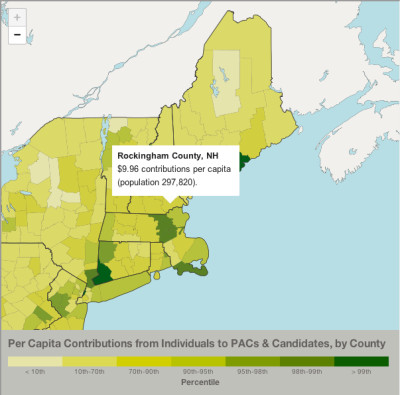 View Larger +
View Larger +
Prev
Next
23. Rockingham County, NH
Contributions, per capita, 2012: $9.96
Total contributions: $2,965,530
Rockingham has 37 communities and has a population of 297,820. Rockingham County also was home to the famous poet, Robert Frost
 View Larger +
View Larger +
Prev
Next
22. Belknap County, NH
Contributions, per capita, 2012: $10.02
Total contributions: $604,512
Belknap County is one of the ten counties in New Hampshire and has a population of 60,327. It is located in the center of New Hampshire and the largest city is Laconia.
 View Larger +
View Larger +
Prev
Next
21. Hampshire County, MA
Contributions, per capita, 2012: $10.41
Total contributions: $1,664,077
Hampshire County has a total area of 545 square miles and is located in the middle of Massachusetts. Hampshire County is also the only county to be surrounded in all directions by other Massachusetts counties.
 View Larger +
View Larger +
Prev
Next
20. Barnstable County, MA
Contributions, per capita, 2012: $10.90
Total contributions: $2,348,541
Barnstable County was founded in 1685 and has three national protected areas. Cape Cod National Seashore is the most famous protected area within Barnstable County and brings in a high amount of tourists every year.
 View Larger +
View Larger +
Prev
Next
19. Berkshire County, MA
Contributions, per capita, 2012: $12.49
Total contributions: $1,624,400
Berkshire County is located on the western side of Massachusetts and borders three different neighboring states. Originally the Mahican Native American Tribe inhabited Berkshire County up until the English settlers arrived and bought the land in 1724.
 View Larger +
View Larger +
Prev
Next
18. Essex County, MA
Contributions, per capita, 2012: $13.22
Total contributions: $9,991,201
Essex is located in the northeastern part of Massachusetts and contains towns such as Salem, Lynn, and Andover. Essex was founded in 1643 and because of Essex historical background, the whole county has been designated as the Essex National Heritage Area.
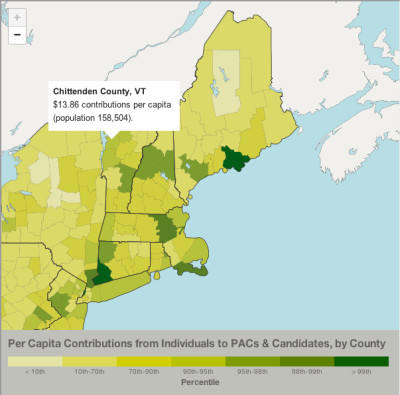 View Larger +
View Larger +
Prev
Next
17. Chittendon County, VT
Contributions, per capita, 2012: $13.86
Total contributions: $2,196,107
Chittenden has a population of 158,504, making it Vermont’s most populated county. Chittenden’s largest city is Burlington, which has about one third of Vermont’s total population.
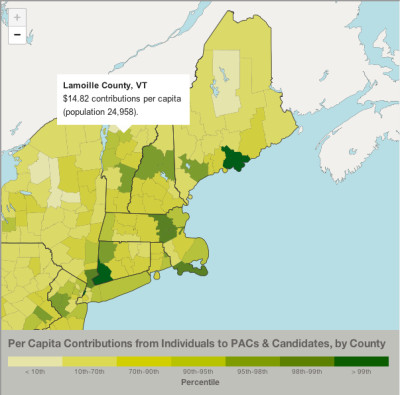 View Larger +
View Larger +
Prev
Next
16. Lamoille County, VT
Contributions, per capita, 2012: $14.82
Total contributions: $369,854
Lamoille County was founded in 1835 and has a population of 24,958. The county has 464 square miles, of which 461 of them are land.
 View Larger +
View Larger +
Prev
Next
15. Addison County, VT
Contributions, per capita, 2012: $15.49
Total contributions: $569,299
Located on the west side of Vermont, Addison County has a total area of 808 square miles. Addison's largest town is Middlebury, where the Community College of Vermont and Middlebury College are located.
 View Larger +
View Larger +
Prev
Next
14. Newport County, RI
Contributions, per capita, 2012: $16.02
Total contributions: $1,214,26
Newport County is one of the five Rhode Island Counties and was founded in 1703. Just like Connecticut, none of Rhode Island counties have an any governmental functions.
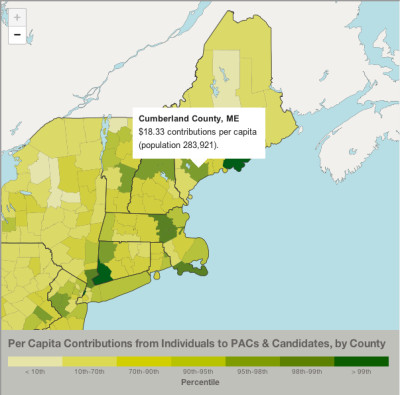 View Larger +
View Larger +
Prev
Next
13. Cumberland County, ME
Contributions, per capita, 2012: $18.33
Total contributions: $5,205,507
Cumberland County has a population of 283,921 and is Maine’s most populated county. The county was named after the William, Duke of Cumberland, a son of King George II.
 View Larger +
View Larger +
Prev
Next
12. Windsor County, VT
Contributions, per capita, 2012: $20.57
Total contributions: $1,156,149
Windsor County is the largest county in Vermont and consists of 971 square miles of land and 5 square miles of water.
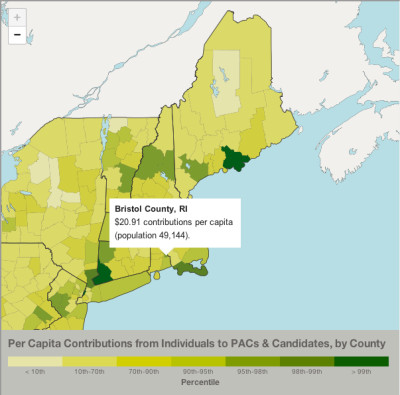 View Larger +
View Larger +
Prev
Next
11. Bristol County, RI
Contributions, per capita, 2012: $20.91
Total contributions: $1,027,472
Bristol County has a population of 49,144 and is the third smallest county in the United States. Bristol County was originally apart of Massachusetts, but was transferred to Rhode Island in 1746.
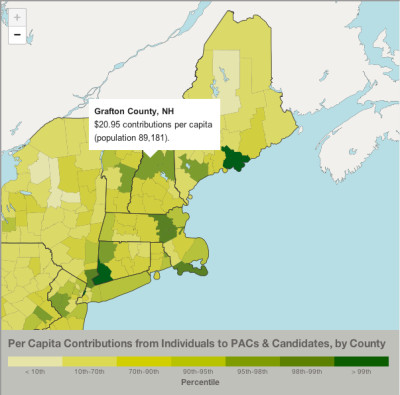 View Larger +
View Larger +
Prev
Next
10. Grafton County, NH
Contributions, per capita, 2012 :$20.95
Total contributions: $1,868,739
With a population of 89,181, Grafton County is the second largest county in New Hampshire. Home of New Hampshire’s only national forest, White Mountain National Forest takes up about half of Grafton’s total area
 View Larger +
View Larger +
Prev
Next
9. Carrol County, NH
Contributions, per capita, 2012: 2012: $22.81
Total contributions: $1,012,10
Created in 1840, Carroll County has a population of 47,567. Carroll County was also named after Charles Carroll, the last surviving signer of the United States Declaration of Independence.
 View Larger +
View Larger +
Prev
Next
8. LItchfield County, CT
Contributions, per capita, 2012: $22.86
Total contributions: $4,286,143
Although it is Connecticut’s largest county, Litchfield has the lowest population density in all of Connecticut. Since 1960 all Connecticut counties have no county government.
_400_395_90.jpg) View Larger +
View Larger +
Prev
Next
7. Middlesex County, MA
Contributions, per capita, 2012: $32.81
Total contributions: $50,432,154
Middlesex County has a population of 1,503,085 and has been ranked as the most populous county in New England. The county government was abolished in 1997, but the county boundaries still exists for court jurisdictions and other administrative purposes.
 View Larger +
View Larger +
Prev
Next
6. Nantucket County, MA
Contributions, per capita, 2012: $33.41
Total contributions: $344,021
Nantucket County consists of a couple of small islands and is a major tourist destination in Massachusetts. Normally Nantucket has a population of 10,298, but during the summer months the population can reach up to 50,000.
 View Larger +
View Larger +
Prev
Next
5. Norfolk County, MA
Contributions, per capita, 2012: $35.87
Total contributions: $24,459,854
Named after a county from England, Norfolk County is the wealthiest county in Massachusetts. As of 2011, Norfolk was ranked the 32nd highest income county in the United States.
 View Larger +
View Larger +
Prev
Next
4. Dukes County, MA
Contributions, per capita, 2012: $36.32
Total contributions: $618,960
Consisting of Martha’s Vineyard and the Elizabeth Islands, Dukes County is one of Massachusetts’ top vacation spots. Originally Dukes County was apart New York, however it was transferred to Massachusetts on October 7, 1691.
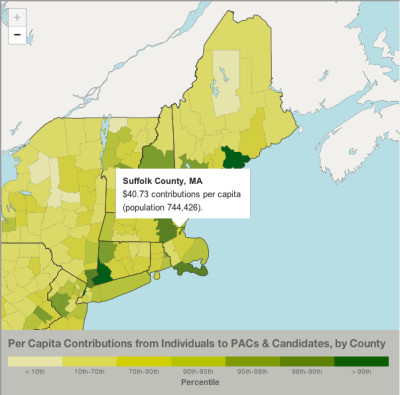 View Larger +
View Larger +
Prev
Next
3. Suffolk County, MA
Contributions, per capita, 2012: $40.73
Total contributions: $30,323,537
Suffolk County has a population of 744,426 and contains Massachusetts’s largest city, Boston. Although Suffolk’s county government was abolished in the late 1900’s, it still remains as a geographic area.
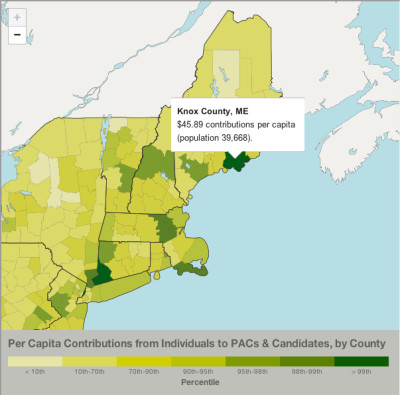 View Larger +
View Larger +
Prev
Next
2. Knox County, ME
Contributions, per capita, 2012: $45.89
Total contributions: $1,820,410
Knox County was established on April 1st, 1860 and was named after American Revolutionary War General Henry Knox. The county has a population of 39,668 and is the home of the Union Fair.
 View Larger +
View Larger +
Prev
Next
1. Fairfield County, CT
Contributions, per capita, 2012: $55.65.
Total contributions: $51,970,701
In a population of 933,835, Fairfield County is the most densely populated county in Connecticut, and contains four of the state's largest cities -- Bridgeport, Stamford, Norwalk and Danbury.
PrevNext
_80_80_90_c1.jpg)
25. Merrimack County, NH
24. Cheshire County, NH
23. Rockingham County, NH
22. Belknap County, NH
21. Hampshire County, MA
20. Barnstable County, MA
19. Berkshire County, MA
18. Essex County, MA
17. Chittendon County, VT
16. Lamoille County, VT
15. Addison County, VT
14. Newport County, RI
13. Cumberland County, ME
12. Windsor County, VT
11. Bristol County, RI
10. Grafton County, NH
9. Carrol County, NH
8. LItchfield County, CT_80_80_90_c1.jpg)
7. Middlesex County, MA
6. Nantucket County, MA
5. Norfolk County, MA
4. Dukes County, MA
3. Suffolk County, MA
2. Knox County, ME
1. Fairfield County, CT
Related Articles
Enjoy this post? Share it with others.




_400_395_90.jpg)

















_400_395_90.jpg)






_80_80_90_c1.jpg)

















_80_80_90_c1.jpg)






